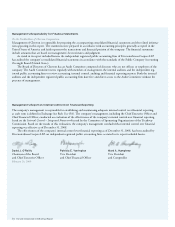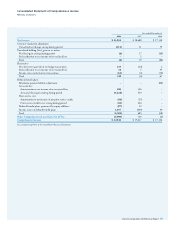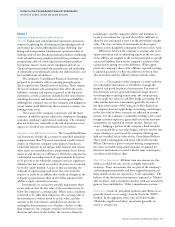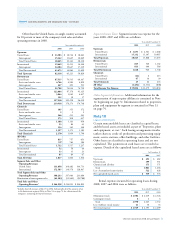Chevron 2008 Annual Report Download - page 67
Download and view the complete annual report
Please find page 67 of the 2008 Chevron annual report below. You can navigate through the pages in the report by either clicking on the pages listed below, or by using the keyword search tool below to find specific information within the annual report.
Chevron Corporation 2008 Annual Report 65
mineral producing properties, a liability for an ARO is made,
following FAS 143. Refer to Note 24, beginning on page 89,
for a discussion of FAS 143.
For federal Superfund sites and analogous sites under
state laws, the company records a liability for its designated
share of the probable and estimable costs and probable
amounts for other potentially responsible parties when man-
dated by the regulatory agencies because the other parties are
not able to pay their respective shares.
The gross amount of environmental liabilities is based
on the company’s best estimate of future costs using currently
available technology and applying current regulations and
the company’s own internal environmental policies. Future
amounts are not discounted. Recoveries or reimbursements
are recorded as assets when receipt is reasonably assured.
Currency Translation The U.S. dollar is the functional cur-
rency for substantially all of the company’s consolidated
operations and those of its equity affiliates. For those opera-
tions, all gains and losses from currency translations are
currently included in income. The cumulative translation
effects for those few entities, both consolidated and affiliated,
using functional currencies other than the U.S. dollar are
included in the currency translation adjustment in “Stock-
holders’ Equity.”
Revenue Recognition Revenues associated with sales of crude
oil, natural gas, coal, petroleum and chemicals products, and
all other sources are recorded when title passes to the customer,
net of royalties, discounts and allowances, as applicable. Rev-
enues from natural gas production from properties in which
Chevron has an interest with other producers are generally
recognized on the basis of the company’s net working interest
(entitle ment method). Excise, value-added and similar taxes
assessed by a governmental authority on a revenue- producing
transaction between a seller and a customer are presented on
a gross basis. The associated amounts are shown as a footnote
to the Consolidated Statement of Income on page 58. Refer
to Note 14, on page 74, for a discussion of the accounting for
buy/sell arrangements.
Stock Options and Other Share-Based Compensation The
company issues stock options and other share-based compen-
sation to its employees and accounts for these transactions
under the provisions of FASB Statement No. 123R, Share-
Based Payment (FAS 123R). For equity awards, such as stock
options, total compensation cost is based on the grant date
fair value and for liability awards, such as stock appreciation
rights, total compensation cost is based on the settlement
value. The company recognizes stock-based compensation
expense for all awards over the service period required to earn
the award, which is the shorter of the vesting period or the
time period an employee becomes eligible to retain the award
at retirement. Stock options and stock appreciation rights
granted under the company’s Long-Term Incentive Plan have
graded vesting provisions by which one-third of each award
vests on the first, second and third anniversaries of the date
of grant. The company amortizes these newly issued graded
awards on a straight-line basis.
Tax benefits of deductions from the exercise of stock
options are presented as financing cash inflows in the
Consolidated Statement of Cash Flows. Refer to Note 21,
beginning on page 80, for a description of the company’s
share-based compensation plans and information related to
awards granted under those plans and Note 2, which follows,
for information on excess tax benefits reported on the com-
pany’s Statement of Cash Flows.
Note 2
Information Relating to the Consolidated Statement of Cash Flows
Year ended December 31
2008 2007 2006
Net (increase) decrease in operating working
capital was composed of the following:
Decrease (increase) in accounts and
notes receivable $ 6,030 $ (3,867) $ 17
Increase in inventories (1,545) (749) (536)
Increase in prepaid expenses and
other current assets (621) (370) (31)
(Decrease) increase in accounts
payable and accrued liabilities (4,628) 4,930 1,246
(Decrease) increase in income and
other taxes payable (909) 741 348
Net (increase) decrease in operating
working capital $ (1,673) $ 685 $ 1,044
Net cash provided by operating
activities includes the following
cash payments for interest and
income taxes:
Interest paid on debt
(net of capitalized interest) $ – $ 203 $ 470
Income taxes $ 19,130 $ 12,340 $ 13,806
Net sales of marketable securities
consisted of the following
gross amounts:
Marketable securities sold $ 3,719 $ 2,160 $ 1,413
Marketable securities purchased (3,236) (1,975) (1,271)
Net sales of marketable securities $ 483 $ 185 $ 142
Note 1 Summary of Significant Accounting Policies – Continued
























